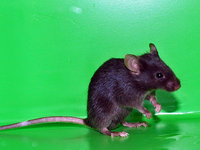Strain Data Sheet
RBRC02412
Strain Information | |
|---|---|
| Image |  |
| BRC No. | RBRC02412 |
| Type | Transgene Congenic |
| Species | Mus musculus |
| Strain name | B6.Cg-Tg(Nes-cre)1Nogu |
| Former Common name | B6.Cg-Tg(Nes-cre)1Nogu |
| H-2 Haplotype | |
| ES Cell line | |
| Background strain | C57BL/6JJcl |
| Appearance | |
| Strain development | Developed by Dr. Shigeru Noguchi, Meiji Dairies Corporation and Kanagawa Academy of Science and Technology and Dr. Toshikuni Sasaoka, Center for Bioresource-based Researches, Brain Research Institute, Niigata University. The transgene was injected into the pronuclei of B6D2F1 fertilized eggs. The mice were backcrossed to C57BL/6. |
| Strain description | Nestin-cre transgenic mice, expressing a cre recombinase gene under the control of Nestin promoter and enhancer. This Nestin-cre transgene contains a rat nestin promoter, cre recombinase gene, IRES-lacZ-polyA and neuron specific enhancer (around 100 bp of exon 1, the entire intron 1 and around 100 bp of exon 3 of nesitin gene). Tissue-specific expression: observed in whole brain, spinal cord and testis/ovary; not observed in thymus, lung, heart, kidney, spleen, stomach, small and large intestine, pancreas, skeletal muscle and tail (Developers, personal communication). |
| Colony maintenance | Backcross to C57BL/6 (Hemizygote x C57BL/6JJcl) |
| References | |
Health Report | |
|---|---|
| Examination Date / Room / Rack | 2025/02/17Room:4-ARack:CSentinel mouse program 2024/11/18Room:4-ARack:CSentinel mouse program 2024/10/29Room:4-ARack:CAdditional tests 2024/08/19Room:4-ARack:CSentinel mouse program 2024/05/20Room:4-ARack:CSentinel mouse program 2024/02/19Room:4-ARack:CSentinel mouse program 2023/11/20Room:4-ARack:CSentinel mouse program 2023/11/13Room:4-ARack:CAdditional tests 2023/08/21Room:4-ARack:CSentinel mouse program 2023/08/07Room:4-ARack:CAdditional tests 2023/05/22Room:4-ARack:CSentinel mouse program |
Gene | |||||||
|---|---|---|---|---|---|---|---|
| Gene Symbol | Gene Name | Chr. | Allele Symbol | Allele Name | Common Names | Promoter | Diseases Related to This Gene |
| IRES | internal ribosomal entry site (EMCV) | UN | |||||
| Nes MGI:101784 | nestin | UN | Nes | ||||
| cre | Phage P1 Cre recombinase | UN | cre | ||||
| lacZ | beta-galactosidase (E. coli) | UN | |||||
| poly A | SV40 polyA signal | UN | poly A | ||||
Phenotype | |
|---|---|
| Annotation by Mammalian phenotyhpe ontology | |
| Detailed phenotype data | |
Ordering Information | |
|---|---|
| Donor DNA | Rat nestin genomic DNA, phage P1 cre recombinase, Encephalomyocarditis virus (EMCV) internal ribosomal entry site (ires) sequence, Simian virus 40 Large T antigen nuclear localization signal (NLS), E. coli lacZ, SV40 poly A |
| Research application | Cre/loxP system Fluorescent Proteins/lacZ System Cre driver |
| Specific Term and Conditions | The RECIPIENT of BIOLOGICAL RESOURCE shall obtain a prior written consent on use of it from the DEPOSITOR. In publishing the research results obtained by use of the BIOLOGICAL RESOURCE, a citation of the literature(s) designated by the DEPOSITOR is requested. The RECIPIENT agrees to use the BIOLOGICAL RESOURCE only for publication of academic research. Prior to publication, the RECIPIENT should contact the developer scientist, Dr. Shigeru Noguchi and acknowledge Drs. Shigeru Noguchi and Dr. Toshikuni Sasaoka. |
| Depositor | Kazuko Hirabayashi (Kanagawa Institute of Industrial Science and Technology) |
| Strain Status |  Live mice Live mice Frozen embryos Frozen embryos Frozen sperm Frozen sperm |
| Strain Availability | Cryopreserved sperm (within 1 month) Cryopreserved embryos (within 1 month) Live mouse (1 to 3 months) |
| Additional Info. | Necessary documents for ordering:
Genotyping protocol -PCR- |
BRC mice in Publications |
|---|
Trifonov S, Yamashita Y, Kase M, Maruyama M, Sugimoto T. Overview and assessment of the histochemical methods and reagents for the detection of β-galactosidase activity in transgenic animals. Anat Sci Int 91(1) 56-67(2016) 26394634 |
Tanaka K, Furuyashiki T, Kitaoka S, Senzai Y, Imoto Y, Segi-Nishida E, Deguchi Y, Breyer RM, Breyer MD, Narumiya S. Prostaglandin E2-mediated attenuation of mesocortical dopaminergic pathway is critical for susceptibility to repeated social defeat stress in mice. J Neurosci 32(12) 4319-29(2012) 22442093 |